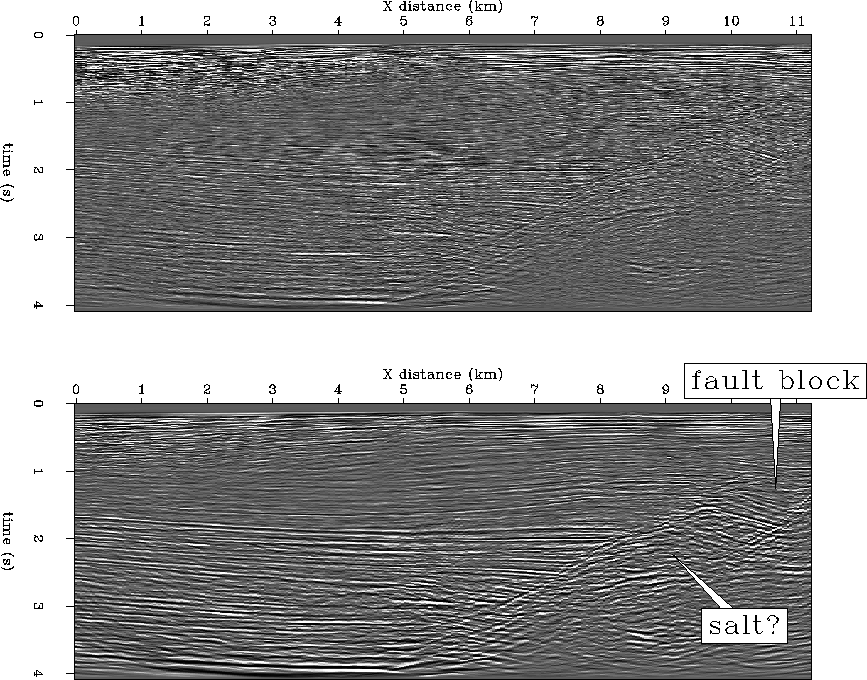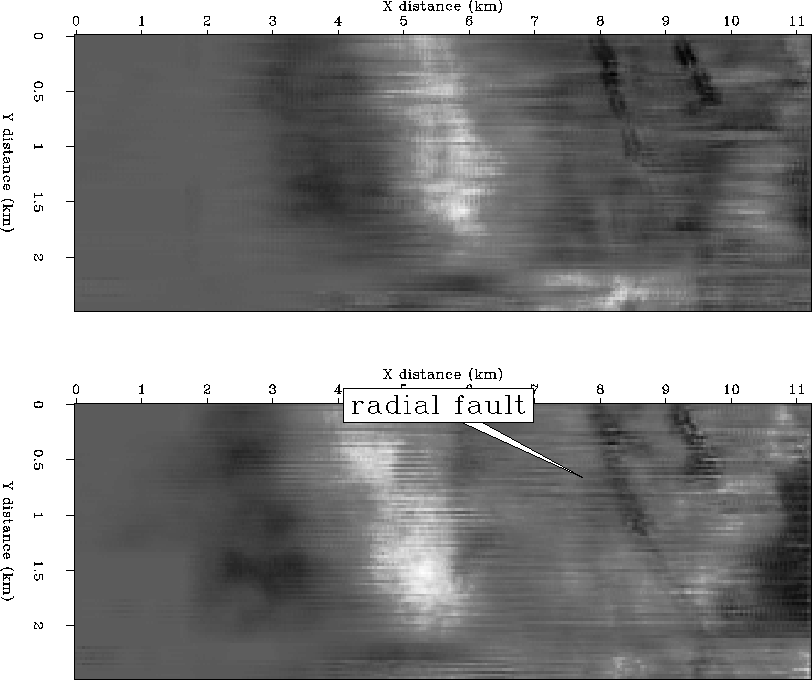




Next: About this document ...
Up: Lumley: Anti-aliased Kirchhoff 3-D
Previous: ACKNOWLEDGMENTS
-
Claerbout, J. F., 1992, Anti aliasing: Stanford Expl. Proj. Report,
73, 371-389.
-
Gray, S. H., 1992, Frequency-selective design of the Kirchhoff migration
operator: Geophysical Prospecting, 40, 565-571.
-
Lumley, D. E., and Biondi, B., 1991, Kirchhoff 3-D prestack time migration
on the Connection Machine: Stanford Expl. Proj. Report, 72,
123-134.
x9-ann
Figure 5 Inline sections sliced from
the standard (upper) and anti-aliased (lower) migration volumes,
at a constant y=0.225 km. The anti-aliased migration
is much more coherent in terms of horizontal structure, a possible
salt-sediment interface or two, and shallow faulting above the
interpreted salt location, including a slightly clockwise-rotated
fault block at 9.5 km and 1.5 seconds.




 x35-ann
x35-ann
Figure 6 Inline sections sliced from
the standard (upper) and anti-aliased (lower) migration volumes,
at a constant y=0.875 km. Again, the anti-aliased migration
is much more coherent, although of notably lower frequency content.
Note the strong salt-sediment interfaces/faults, and the
strongly clockwise-rotated fault block at 10.5 km and 1.5 seconds.




 x92-ann
x92-ann
Figure 7 Inline sections sliced from
the standard (upper) and anti-aliased (lower) migration volumes,
at a constant y=2.300 km. A salt peak is clearly visible
at 8.5 km and 1.5 seconds in the anti-aliased image. This
interpretation would be much more challenging given only the
standard image in the upper panel.




 y191-ann
y191-ann
Figure 8 Crossline sections sliced from
the standard (left) and anti-aliased (right) migration volumes,
at a constant x=7.163 km. Note the coherent resolution of the
anticlinal sediment structure in the anti-aliased migration
panel. With a little imagination, we might be seeing the top
of salt which underlays the sediment package at 2.5 seconds,
and the fuzzy bottom of the salt lens intrusion at 3.0 seconds.




 z16-ann
z16-ann
Figure 9 Time slices cut from each of
the standard (upper) and anti-aliased (lower) migration volumes,
at a constant  seconds. The anti-aliased time slice
shows a continuous 3.0 km long radial fault associated with the
salt intrusion.
seconds. The anti-aliased time slice
shows a continuous 3.0 km long radial fault associated with the
salt intrusion.




 z219-ann
z219-ann
Figure 10 Time slices cut from each of
the standard (upper) and anti-aliased (lower) migration volumes,
at a constant  seconds. The salt peak has clearly
penetrated
the anticlinal sediment structure in the lower right corner of
the plot. A radial fault (salt-filled?) is barely discernible,
but definitely seems to curve into the major discontinuity in
folded sediments at
seconds. The salt peak has clearly
penetrated
the anticlinal sediment structure in the lower right corner of
the plot. A radial fault (salt-filled?) is barely discernible,
but definitely seems to curve into the major discontinuity in
folded sediments at  km.
km.




 z235-ann
z235-ann
Figure 11 Time slices cut from each of
the standard (upper) and anti-aliased (lower) migration volumes,
at a constant  seconds. Two radial faults are clearly
imaged, which bound a fault block containing reflectors that
dip steeply and acutely into the plane of the page, especially at
x=9.5 km in the y=1.5 km range. In contrast,
the anticlinal sediment structure to the left dips more within
the horizontal plane of the page.
seconds. Two radial faults are clearly
imaged, which bound a fault block containing reflectors that
dip steeply and acutely into the plane of the page, especially at
x=9.5 km in the y=1.5 km range. In contrast,
the anticlinal sediment structure to the left dips more within
the horizontal plane of the page.










Next: About this document ...
Up: Lumley: Anti-aliased Kirchhoff 3-D
Previous: ACKNOWLEDGMENTS
Stanford Exploration Project
11/17/1997






